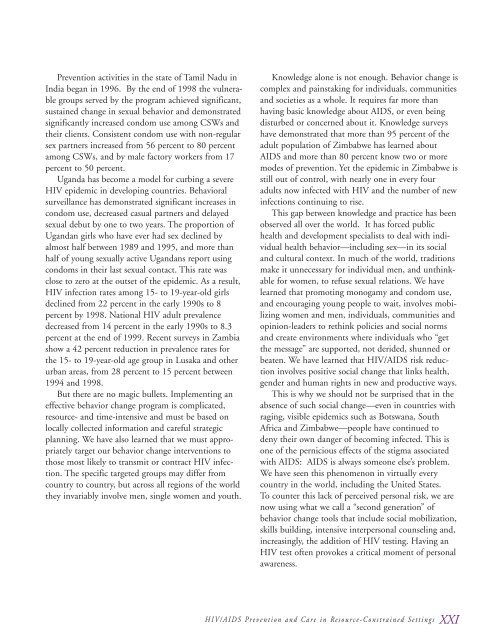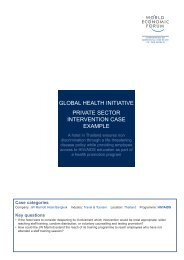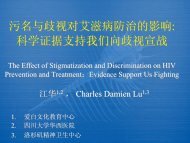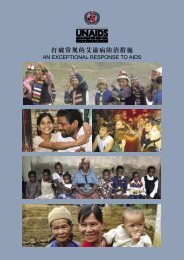X HIV/AIDS Prevention and Care in Resource-Constrained Settings
X HIV/AIDS Prevention and Care in Resource-Constrained Settings
X HIV/AIDS Prevention and Care in Resource-Constrained Settings
- No tags were found...
You also want an ePaper? Increase the reach of your titles
YUMPU automatically turns print PDFs into web optimized ePapers that Google loves.
<strong>Prevention</strong> activities <strong>in</strong> the state of Tamil Nadu <strong>in</strong>India began <strong>in</strong> 1996. By the end of 1998 the vulnerablegroups served by the program achieved significant,susta<strong>in</strong>ed change <strong>in</strong> sexual behavior <strong>and</strong> demonstratedsignificantly <strong>in</strong>creased condom use among CSWs <strong>and</strong>their clients. Consistent condom use with non-regularsex partners <strong>in</strong>creased from 56 percent to 80 percentamong CSWs, <strong>and</strong> by male factory workers from 17percent to 50 percent.Ug<strong>and</strong>a has become a model for curb<strong>in</strong>g a severe<strong>HIV</strong> epidemic <strong>in</strong> develop<strong>in</strong>g countries. Behavioralsurveillance has demonstrated significant <strong>in</strong>creases <strong>in</strong>condom use, decreased casual partners <strong>and</strong> delayedsexual debut by one to two years. The proportion ofUg<strong>and</strong>an girls who have ever had sex decl<strong>in</strong>ed byalmost half between 1989 <strong>and</strong> 1995, <strong>and</strong> more thanhalf of young sexually active Ug<strong>and</strong>ans report us<strong>in</strong>gcondoms <strong>in</strong> their last sexual contact. This rate wasclose to zero at the outset of the epidemic. As a result,<strong>HIV</strong> <strong>in</strong>fection rates among 15- to 19-year-old girlsdecl<strong>in</strong>ed from 22 percent <strong>in</strong> the early 1990s to 8percent by 1998. National <strong>HIV</strong> adult prevalencedecreased from 14 percent <strong>in</strong> the early 1990s to 8.3percent at the end of 1999. Recent surveys <strong>in</strong> Zambiashow a 42 percent reduction <strong>in</strong> prevalence rates forthe 15- to 19-year-old age group <strong>in</strong> Lusaka <strong>and</strong> otherurban areas, from 28 percent to 15 percent between1994 <strong>and</strong> 1998.But there are no magic bullets. Implement<strong>in</strong>g aneffective behavior change program is complicated,resource- <strong>and</strong> time-<strong>in</strong>tensive <strong>and</strong> must be based onlocally collected <strong>in</strong>formation <strong>and</strong> careful strategicplann<strong>in</strong>g. We have also learned that we must appropriatelytarget our behavior change <strong>in</strong>terventions tothose most likely to transmit or contract <strong>HIV</strong> <strong>in</strong>fection.The specific targeted groups may differ fromcountry to country, but across all regions of the worldthey <strong>in</strong>variably <strong>in</strong>volve men, s<strong>in</strong>gle women <strong>and</strong> youth.Knowledge alone is not enough. Behavior change iscomplex <strong>and</strong> pa<strong>in</strong>stak<strong>in</strong>g for <strong>in</strong>dividuals, communities<strong>and</strong> societies as a whole. It requires far more thanhav<strong>in</strong>g basic knowledge about <strong>AIDS</strong>, or even be<strong>in</strong>gdisturbed or concerned about it. Knowledge surveyshave demonstrated that more than 95 percent of theadult population of Zimbabwe has learned about<strong>AIDS</strong> <strong>and</strong> more than 80 percent know two or moremodes of prevention. Yet the epidemic <strong>in</strong> Zimbabwe isstill out of control, with nearly one <strong>in</strong> every fouradults now <strong>in</strong>fected with <strong>HIV</strong> <strong>and</strong> the number of new<strong>in</strong>fections cont<strong>in</strong>u<strong>in</strong>g to rise.This gap between knowledge <strong>and</strong> practice has beenobserved all over the world. It has forced publichealth <strong>and</strong> development specialists to deal with <strong>in</strong>dividualhealth behavior—<strong>in</strong>clud<strong>in</strong>g sex—<strong>in</strong> its social<strong>and</strong> cultural context. In much of the world, traditionsmake it unnecessary for <strong>in</strong>dividual men, <strong>and</strong> unth<strong>in</strong>kablefor women, to refuse sexual relations. We havelearned that promot<strong>in</strong>g monogamy <strong>and</strong> condom use,<strong>and</strong> encourag<strong>in</strong>g young people to wait, <strong>in</strong>volves mobiliz<strong>in</strong>gwomen <strong>and</strong> men, <strong>in</strong>dividuals, communities <strong>and</strong>op<strong>in</strong>ion-leaders to reth<strong>in</strong>k policies <strong>and</strong> social norms<strong>and</strong> create environments where <strong>in</strong>dividuals who “getthe message” are supported, not derided, shunned orbeaten. We have learned that <strong>HIV</strong>/<strong>AIDS</strong> risk reduction<strong>in</strong>volves positive social change that l<strong>in</strong>ks health,gender <strong>and</strong> human rights <strong>in</strong> new <strong>and</strong> productive ways.This is why we should not be surprised that <strong>in</strong> theabsence of such social change—even <strong>in</strong> countries withrag<strong>in</strong>g, visible epidemics such as Botswana, SouthAfrica <strong>and</strong> Zimbabwe—people have cont<strong>in</strong>ued todeny their own danger of becom<strong>in</strong>g <strong>in</strong>fected. This isone of the pernicious effects of the stigma associatedwith <strong>AIDS</strong>: <strong>AIDS</strong> is always someone else’s problem.We have seen this phenomenon <strong>in</strong> virtually everycountry <strong>in</strong> the world, <strong>in</strong>clud<strong>in</strong>g the United States.To counter this lack of perceived personal risk, we arenow us<strong>in</strong>g what we call a “second generation” ofbehavior change tools that <strong>in</strong>clude social mobilization,skills build<strong>in</strong>g, <strong>in</strong>tensive <strong>in</strong>terpersonal counsel<strong>in</strong>g <strong>and</strong>,<strong>in</strong>creas<strong>in</strong>gly, the addition of <strong>HIV</strong> test<strong>in</strong>g. Hav<strong>in</strong>g an<strong>HIV</strong> test often provokes a critical moment of personalawareness.<strong>HIV</strong>/<strong>AIDS</strong> <strong>Prevention</strong> <strong>and</strong> <strong>Care</strong> <strong>in</strong> <strong>Resource</strong>-Constra<strong>in</strong>ed Sett<strong>in</strong>gs XXI
















